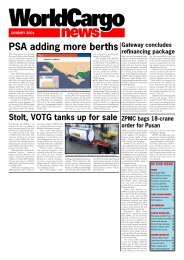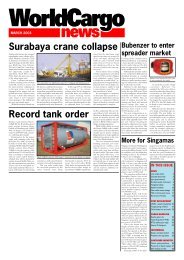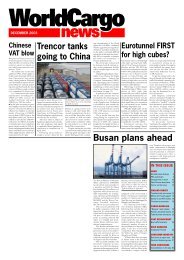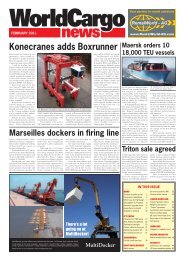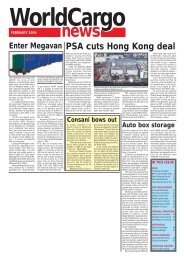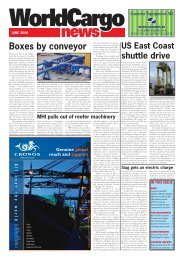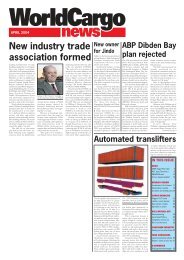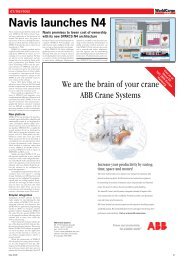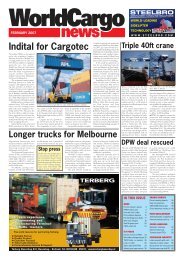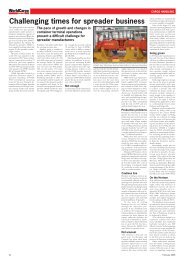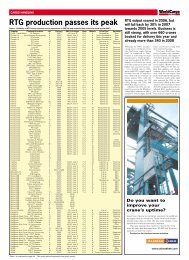WorldCargo News Online
WorldCargo News Online
WorldCargo News Online
Create successful ePaper yourself
Turn your PDF publications into a flip-book with our unique Google optimized e-Paper software.
CARGO HANDLING<br />
<strong>WorldCargo</strong><br />
news<br />
Left: the new cranes and shuttle carriers have<br />
led to a dramtic improvement in productivity<br />
and lines are calling with bigger ships and<br />
making more exchanges. The picture on the<br />
right shows the buffer storage area<br />
ture with TrackWheel, a previous Kalmar<br />
dealer, to supply and maintain the cargo<br />
handling equipment. SP Satria is the exclusive<br />
supplier of port equipment to<br />
Sabah Ports and also the exclusive agent<br />
for Kalmar and Gottwald in Sabah.<br />
SP Satria aims to provide services not<br />
just to Sabah Ports but eventually to other<br />
ports in Malaysia and the south east Asian<br />
region.The Suria Group has a one year<br />
consultancy agreement with Kalmar Asia<br />
under which Kalmar will train SP Satria’s<br />
maintenance and operational staff. Malay<br />
speaking engineers from Kalmar Singa-<br />
pore have been training around 80 SP<br />
Satria service personnel on site and some<br />
have been sent to Kalmar training centres<br />
in Shekou and Finland. ❏<br />
be managed by reach stackers and SP<br />
Satria is finalising an order for 14 machines<br />
with Kalmar. Stacking capacity is<br />
the main reason for selecting reach stackers<br />
and they are expected to be sufficient<br />
until throughput hits 300,000 TEU, at<br />
which point RTGs will be considered.<br />
Throughput at Kota Kinabalu grew 2%<br />
to 142,000 TEU last year, so the switch is<br />
some way off.<br />
With no shuttle carriers required for<br />
yard work, only five of the seven machines<br />
will be taken to Sepangar Bay; the other<br />
two will be used at other terminals in the<br />
Suria Group. Some of the straddle carriers<br />
may be transferred elsewhere as well<br />
or else sold off. This is Ahmat’s preference<br />
as many are very old and they are<br />
being phased out anyway.<br />
Other systems being implemented at<br />
Sepangar Bay include Cosmos operating<br />
software and a new billing module being<br />
developed by Suria Group’s IT subsidiary<br />
Tricubes Suria Sdn Bhd.The Cosmos<br />
TOS will replace the existing system developed<br />
by Malaysia’s Portrade.<br />
Training and maintenance<br />
Sabah Ports has met lines’ requirements<br />
for 15 moves per hour but recognised it<br />
needed to improve driver behaviour and<br />
maintenance to sustain and improve this<br />
over time.A subsidiary company, SP Satria<br />
Sdn Bhd, has been set up in a joint ven-<br />
Sabah irony<br />
There is no small irony that the biggest<br />
application for shuttle carriers so far is in<br />
harness with tractor/trailer sets (IMVs)<br />
and not a replacement for them!<br />
As originally conceived for high<br />
throughput container terminals in northern<br />
Europe, the shuttle carrier is a “short<br />
circuit” interface between the quay cranes<br />
and the shipside end of an automated container<br />
stack that is aligned transversally to<br />
the quay. Shuttle carriers are not good<br />
“running mates” for RTG stacks, however<br />
they are aligned, because the conventional<br />
road lane is not wide enough<br />
for two machines to pass.<br />
Depending on design, number ordered<br />
, etc, a “ballpark” price for a shuttle<br />
carrier is thought to work out at around<br />
2.5 times the price of an IMV, but it probably<br />
needs to replace only two IMVs to<br />
be cost-effective because of the saving in<br />
manpower.<br />
If one adds the productivity bonus of<br />
breaking the handling chain at both the<br />
stack and quayside interfaces compared<br />
to a conventional IMV yard-quay dray,<br />
the cost:benefit ratio looks likely to favour<br />
the shuttle carrier even more.<br />
The drawbacks are machine complexity<br />
and higher costs for maintenenace<br />
and service, along with driver training issues,<br />
possible restrictions on wheel loads<br />
and the general “unfamiliarity” with straddle<br />
carriers in many RTG terminals.<br />
One way to reduce deadweight is to<br />
cut the shuttle carrier down to 1 over 0<br />
or 1 over chassis size This reduces flexibility.<br />
In the early days of shuttle carrier<br />
concepts, there were outline designs for<br />
these lower height versions, but interest<br />
in them waned.<br />
However, there is evidence that interest<br />
has increased again, as “niche” machines<br />
for low throughput operations inland<br />
as well as portside. Kalmar, Noell,<br />
CVS and Consens are all believed to have<br />
some interesting designs on the way. ❏<br />
April 2006 19



